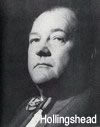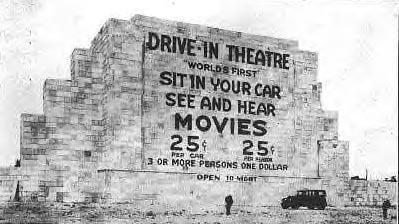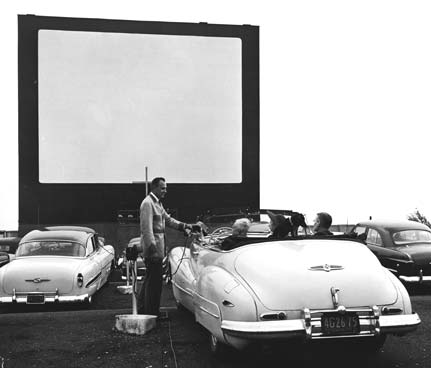CLICK TO VOTE ON A THIRD FEATURE AT YOUR DRIVE-IN BELOW FOR SATURDAY JUNE 6th:
5Drive-In Oakville
Starlite Hamilton
Mustang London
Sunset Barrie
Stardust Newmarket
The Inventor
 In l933, Richard Hollingshead invented the drive-in movie theatre, a cinema for Americans infatuated with the automobile. Always on the lookout for new ideas, as the son of the owner of “Whiz Auto Products Company,” Hollingshead considered the buying habits of Americans and recognized that people gave up food, clothing, autos and movies last, in that order. Seeking to capitalize on this realization, noticing that despite the depression, people continued to go to the movies at their local theatres, Hollingshead, driven by his entrepreneurial spirit, began to experiment with the concept of the outdoor theater in his back yard on 212 Thomas Avenue in Riverton, New Jersey. He began by placing an old Kodak projector on the hood of his car, projecting the movie onto a screen nailed to a tree. Simulating rainfall with a sprinkler, placing a radio behind the screen to provide sound, Hollingshead moved towards the crucial concept of the drive-in, ensuring that all of the vehicles had an un-obstructed view of the screen. After experimenting with various arrangements and configurations he finally solved the visibility problem by envisioning a series of terraced rows with raised ramps providing an unobstructed view for all cars.
In l933, Richard Hollingshead invented the drive-in movie theatre, a cinema for Americans infatuated with the automobile. Always on the lookout for new ideas, as the son of the owner of “Whiz Auto Products Company,” Hollingshead considered the buying habits of Americans and recognized that people gave up food, clothing, autos and movies last, in that order. Seeking to capitalize on this realization, noticing that despite the depression, people continued to go to the movies at their local theatres, Hollingshead, driven by his entrepreneurial spirit, began to experiment with the concept of the outdoor theater in his back yard on 212 Thomas Avenue in Riverton, New Jersey. He began by placing an old Kodak projector on the hood of his car, projecting the movie onto a screen nailed to a tree. Simulating rainfall with a sprinkler, placing a radio behind the screen to provide sound, Hollingshead moved towards the crucial concept of the drive-in, ensuring that all of the vehicles had an un-obstructed view of the screen. After experimenting with various arrangements and configurations he finally solved the visibility problem by envisioning a series of terraced rows with raised ramps providing an unobstructed view for all cars.
The Patent
 After conceptualizing this unique arrangement of ramps as the core concept behind the idea of the drive-in, Hollingshead felt that it was specialized enough to be patented, which would allow him to collect royalties from future drive-in operators for a period of 17 years (the standard time limit for patents). He filed an application for the patent on August 6, 1932, and it was later granted by the patent office on May 16, 1933 under patent number 1,909,537.
After conceptualizing this unique arrangement of ramps as the core concept behind the idea of the drive-in, Hollingshead felt that it was specialized enough to be patented, which would allow him to collect royalties from future drive-in operators for a period of 17 years (the standard time limit for patents). He filed an application for the patent on August 6, 1932, and it was later granted by the patent office on May 16, 1933 under patent number 1,909,537.
Investors
Financial backing came from Willie Warren Smith, Hollingshead’s first cousin and parking lot operator, who, along with Hollingshead, formed a company,Park-In Theaters Inc. Along with Smith, road contractor, Edward Ellis, was brought in to grade the lot of the first theater in exchange for stock. Oliver Willets, an executive of Campbell’s Soup, also bought stock in the company in order to get things off the ground.
The First Drive-in
On May 16, 1933, the day the patent was granted, construction began on the fist drive-in on Crescent Boulevard in Pennsauken Township, New Jersey. (While the location is usually reported as Admiral Wilson Blvd. in Camden, the theater was technically over the Camden town line, where the name of the road changes.)
 Holding under 400 cars, this first drive-in had large trees and fencing around it in order to prevent people from seeing the screen from outside the lot. The screen was 30 ft. high, 40 ft. wide, and 12 ft. from the ground and was housed by a larger structure that was 149 ft. wide, 35 ft. high, and 60 ft. deep. The field was paved with gravel and oiled to keep dust down and mosquitoes away. Sound was supplied by 3 six-foot square RCA speakers and could be heard from miles around. The hallmark concession stand was added after the first week. Total cost was published at $60,000, but considering the small size of this first drive-in, as well as more reliable figures for later 30’s drive-ins, this figure is highly exaggerated. A cost around $30,000 is probably closer to the mark.
Holding under 400 cars, this first drive-in had large trees and fencing around it in order to prevent people from seeing the screen from outside the lot. The screen was 30 ft. high, 40 ft. wide, and 12 ft. from the ground and was housed by a larger structure that was 149 ft. wide, 35 ft. high, and 60 ft. deep. The field was paved with gravel and oiled to keep dust down and mosquitoes away. Sound was supplied by 3 six-foot square RCA speakers and could be heard from miles around. The hallmark concession stand was added after the first week. Total cost was published at $60,000, but considering the small size of this first drive-in, as well as more reliable figures for later 30’s drive-ins, this figure is highly exaggerated. A cost around $30,000 is probably closer to the mark.
June 6, 1933 marked opening night at the “Drive-In Theater,” as it was called (although the actual name was the “Automobile Movie Theater”). Cars packed into the terraced theater to see the 1932 release of “Wives Beware,” which was in second-run status at the time. Admission was 25 cents for each car and an additional 25 cents for each person, which at the time, was somewhat higher than the price at indoor movie houses.
Promotion
Hollingshead promoted the drive-in concept by endorsing the numerous advantages it afforded to patrons, such as the option of smoking without bothering anyone or violating fire laws, talking in your car without disturbing neighbors, eating in the privacy of your vehicle, and eliminating the need for babysitters, since children could be brought along in their pajamas and sleep in the back seat. The aged and infirm and severely overweight individuals also benefited, as the narrow aisles and small seats of indoor houses posed problems that the drive-in purged.
FUN FACT: One early backlash to drive-ins was a “Babysitter Protest” with picketing teenage girls marching around with signs that read “Down with Drive-Ins, More Work for Babysitters.”
Showing Films
While it was initially thought that 3 shows a night would be viable, after only 2 nights, the drive-in began showing only 2 shows per night, one at 8:45 and another at 10:45. In the early days of movie theatres, it was possible for a small town house or DI to get 2-3 changes a week, which meant that if the theater were drawing from a small local population, it had something fresh every few days to keep people  coming in. Today, it is not unusual for big studios and distributors to force exhibitors to show a film for a minimum of 4 weeks. While this can be negotiated down, it really hurts attendance when most of the audience sees the new release on the first weekend and then the theater is dead for the next 3 weeks waiting for the next new film. This led to most theaters becoming twinned and tripled until the dawn and proliferation of the indoor multi-plex and mega-plexes we see everywhere today. With 15 screens or more, these theaters always offer something new to see and led to the closing of many drive-ins and small neighborhood houses.
coming in. Today, it is not unusual for big studios and distributors to force exhibitors to show a film for a minimum of 4 weeks. While this can be negotiated down, it really hurts attendance when most of the audience sees the new release on the first weekend and then the theater is dead for the next 3 weeks waiting for the next new film. This led to most theaters becoming twinned and tripled until the dawn and proliferation of the indoor multi-plex and mega-plexes we see everywhere today. With 15 screens or more, these theaters always offer something new to see and led to the closing of many drive-ins and small neighborhood houses.
Early Problems
Despite the excitement surrounding the idea of the drive-in, this first theater did not last long. It was closed by 1936 and “moved” to Union, New Jersey by the man who bought it from Hollingshead. While Hollingshead sited high film rental costs as the major reason behind the drive-in’s lack of profitability (he paid $400 for a 4-day rental of “Wives Beware” when Hollywood studios made it available to indoor exhibitors for $20 a week), there were additional reasons for the closure. The sound was horrible and was not synchronized with the screen due to the delay caused by the location of the speakers near the screen, the insects bothered patrons, the ticket prices were higher than indoor houses, and the single bill policy also contributed to its closing.
